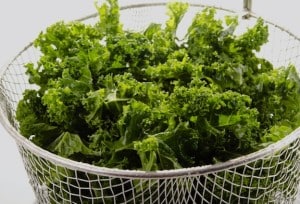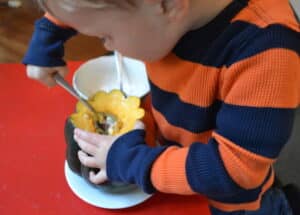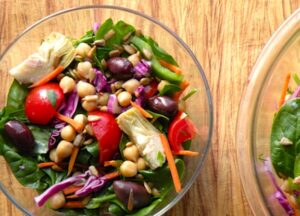The number one question most parents ask about how to change kids’ eating habits is “how do you get your kids to eat a wider variety of foods?” I have lost count how many times I’ve heard parents say, “My kids:
…hate vegetables.”
…would starve if we didn't feed them x or y.”
…are the pickiest eaters in the world.”
…would never eat that.”
All these parental opinions about their kids eating preferences may be rooted in one underlying issue: Kids are afraid of new foods. In order to get past the fear, kids need to build familiarity with the ingredients so that they aren’t new anymore.
In my upcoming book I offer many strategies and techniques parents can use to accomplish that goal, but in this post I will focus on one: get kids into the kitchen. It’s the easiest way kids can learn how foods look in their original form, and how they can be manipulated and cooked into meals.
There is no age that is “too early” to start doing this- even 1 year olds can start getting their hands dirty. In the picture to the right the father and son duo are working together to make some fresh juice. The little boy is one, and is loving every moment of helping load the ingredients into the juicer. It's a win win method to get kids to help and for them to touch, smell and observe how fresh juice is made.
 One of the common items we put into juice is fresh kale. Because he had the opportunity to "play" with it, and he knows it is one of the ingredients in a beverage he enjoys is one of the reasons he isn't afraid to eat it raw now that he is older. As a two and half year old he happily reaches for it at the store and nibbles on it as a snack.
One of the common items we put into juice is fresh kale. Because he had the opportunity to "play" with it, and he knows it is one of the ingredients in a beverage he enjoys is one of the reasons he isn't afraid to eat it raw now that he is older. As a two and half year old he happily reaches for it at the store and nibbles on it as a snack.
Plus, toddlers love to participate in the activities the parents are doing. By “helping” the parents they feel like they are an activate contributor to the household and have a purpose within the family unit. Even though it may seem like a disadvantage at first because cooking will take longer to finish, in the end it’ll contribute to a feeling of closeness among all the family members- an essential emotion for a healthy family bond to last into their adulthood.
In order to have a positive experience in the kitchen with the kids there are several steps that should be taken:
Parents need to change their mindset
Preparing meals should be viewed as a family event- not a chore that one parent is responsible for while the other entertains the kids (which may not even be possible if it’s a one parent household). This is an opportunity for everyone to spend quality time together. As the kids grow they will prefer to hang out with their friends, and we’ll be wishing to return to the moments when they were young and only wanted to spend time with us.
If you have toddler aged kids then your main competition for your kids attention is one of their toys. By providing them with an engaging activity in the kitchen they will happily join you.
If you have older children they will probably appreciate your invitation, and without the distraction of smart phones and tv’s you’ll have the opportunity to have more in depth conversation.
Take advantage of your kids’ curiosity
 Kids are by nature highly curious creatures. They notice everything. This characteristic is perfect for food discovery. Take the time to talk about the different features of produce. Smell the spices. Observe how rice changes size as it cooks. Roll sticky dates in nuts. Your kids will be fascinated with the mini-science experiments that the kitchen has to offer. You might even experience moments of quietness as they get entrenched in exploring the different properties of foods. This is the perfect place for kids to experiment. You can also give them the choice for selecting ingredients to put into a dish.
Kids are by nature highly curious creatures. They notice everything. This characteristic is perfect for food discovery. Take the time to talk about the different features of produce. Smell the spices. Observe how rice changes size as it cooks. Roll sticky dates in nuts. Your kids will be fascinated with the mini-science experiments that the kitchen has to offer. You might even experience moments of quietness as they get entrenched in exploring the different properties of foods. This is the perfect place for kids to experiment. You can also give them the choice for selecting ingredients to put into a dish.
Get kid-sized tools and furniture
The kids need to be comfortable. Invest a little bit of money into getting furniture and cooking tools that will fit them. Chairs, table, step stool, cooking utensils, bowls, etc. You probably already have most of these in the home, but if not, a couple of great resources are Montessori, which specializes in providing products that are specifically designed for little bodies. They offer a wide variety of kitchen tools that are safe and ergonomic; and Ikea Kids, which has everything from furniture to cooking tools that are affordable, and practical.
There is a job for everyone
Divide up the work among the whole family. This is pretty self-explanatory, but it can be a little tricky when you aren’t sure what the younger kids can handle, and if you have more than one child. If your kids are really little (1 to 3 yrs old), they will need to be closely supervised, and will need help to guide their hands with specific tasks. With child-safe knives, you can place your hands above theirs and chop vegetables together. They can help load ingredients into mixers. As they get bigger they can fill measuring spoons on their own. Mix ingredients. Stir. When they learn to read have them read the recipe instructions out loud. Eventually they can manage a recipe from start to finish on their own.
If you have multiple kids one person can measure another can mix. One child can mix the wet ingredients, while the other takes care of the dry. Divide the responsibility between each step of the instruction, and level of mobility skill. However you choose to split the work, each person should feel like they had a part in making the meal.
Set aside time to do the cooking
You might still be saying to yourself, “but this will take forever!” Well, most likely it will take longer to cook. So yes, if it’s 7 PM and you’re exhausted because you just got home, you're starving, and you wanted food on the table 5 minutes ago, this won’t work. Obviously cooking with kids requires a little bit of a time commitment, which is why you need to set aside time to do this. Pick one day a week when you aren’t pressed for time, usually the weekend is the most optimal. If you batch cook all your meals for the week on Sunday then that’s a perfect time to include the kids. Even if they only join you in preparing one meal a week, that’ll work too.
If you cook as you go during the week, focus on getting them to join you when you are cooking with ingredients that are new to them, or they generally choose to avoid.
Don’t expect your kids to fall in love with everything you cook together
You start cooking together, you follow all the advice, the kids even looked like they enjoyed the cooking process, but they still wont actually eat the food! That’s OK! They might not be ready to try it, or maybe the dish just doesn’t taste good — that happens even to the best chef. Remember the whole point is to help them build familiarity with the ingredients, not to force them to eat. Eventually, as they are exposed to a bigger and bigger list of ingredients, they will be more tempted to try some of it. At the end, what they choose to eat will be a wider selection of foods than if they didn't participate in cooking with you.
On a personal level, when those little hands are in the kitchen with me, I can actually see my son’s mind actively learning and engaging with the world around him. He is an energetic 2 year old who loves to participate when I’m cooking. If we need to get something from the refrigerator I’ll hear an automatic “I’ll get that, Mama.” And those little feet will shuffle to bring his stool close to the refrigerator door. Opens the door. Moves the stool to the right spot to reach what we need. Brings me the ingredient. Goes back to the refrigerator, moves the stool out of the way, closes the door. Brings the stool back to the counter so that he can see how we’ll use it.
So much commotion and movement to just bring the almond milk. And I love every bit of it. Every time we cook together he manages to surprise me. Now that he is a little bigger, he is helping me chop vegetables. Recently he said “I want to try it,” as we’re cutting onions — raw yellow onions. Trying to not discourage him, I said “OK.” With every ounce of strength inside me, I hold myself back from showing any reaction on my face.
“What did you think?” I ask.
“Hmm, more.” And he eagerly reached for seconds. I hide my shock, and quietly adore this moment as he embraces a new discovery.
There is a bonding energy that is shared between us in these moments. He’s not just helping make lunch or dinner. He is absorbing life long skills that will build his confidence and independence.
 The photo at left is from a recent attempt at making stuffed acorn squash together. The little guy helped take out seeds, and put in the filling. Unfortunately, the final product wasn’t the best tasting dish, so I won’t share the recipe, but we had a lot of fun cooking it. He even took a few bites to try it before turning it down. That’s OK. As long as he tried it, right?
The photo at left is from a recent attempt at making stuffed acorn squash together. The little guy helped take out seeds, and put in the filling. Unfortunately, the final product wasn’t the best tasting dish, so I won’t share the recipe, but we had a lot of fun cooking it. He even took a few bites to try it before turning it down. That’s OK. As long as he tried it, right?
Article and photos contributed by Sophia Dubrovsky from Plant Based Made Easy.
Sophia offers cooking classes, kitchen detox, nutrition seminars, and other services to help you live a healthier life. Find out more here.
- Find lots more recipe and tips at Veg Kids and Teens.






Comments
No Comments